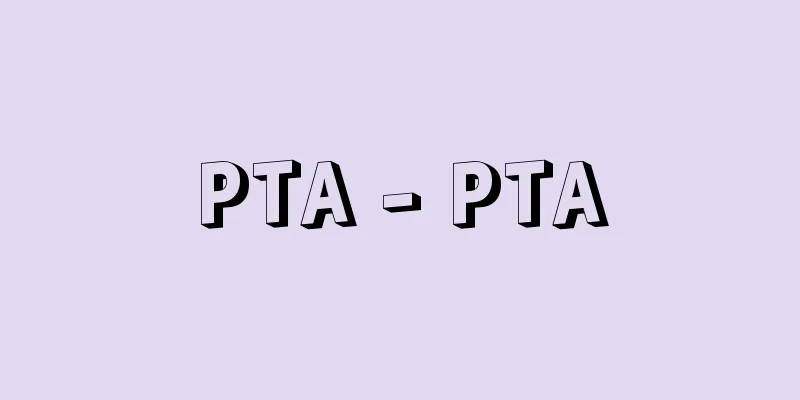PTA - PTA

|
An educational organization made up of parents and teachers (educational staff) who aim to foster a better educational environment for children and students. The acronym stands for parent-teacher association. A PTA organized for each school is called a local PTA. Local PTAs generally belong to municipal, county, prefectural, or even national PTA federations in order to solve problems more effectively and appropriately, or to solve wide-area problems that go beyond a single school, and also to exchange information and coordinate activities. It is well known that the Japanese PTA was modeled on the American PTA. Even before the end of World War II in Japan, there were many educational organizations similar to the PTA under the name of parents' association or parents' association, but from around 1947 (Showa 22) PTAs were rapidly formed in elementary, junior high, and high schools across the country as democratic educational organizations that were distinct from those organizations in terms of purpose and organization. [Isao Tsuji] American PTAWhen discussing the American PTA, it is necessary to distinguish between PTA as a proper noun in English and PTA as a general noun. PTA as a general noun includes organizations that do not have the PTA as their name but are called PTA because of their activities (although there are a few PTA organizations in Japan that do not have the PTA name). The model for the formation of the Japanese PTA was the PTA as a proper noun. This organization originated from the National Congress of Mothers, which was founded in 1897 in Washington, D.C., at the suggestion of two mothers, Alice M. Birney and Phoebe A. Hearst. In 1924, the same council was renamed the National Congress of Parents and Teachers, and today it is known as the National PTA, with approximately 26,000 local PTAs and a membership of approximately 6.5 million (as of 2000). This PTA is characterized by its broad educational goals, including respect for human values, expansion of educational opportunities, development of professional skills, protection of natural resources, international understanding, and civic responsibility, and by the wide range of activities it undertakes. It is also often noted that a significant proportion of its members are fathers and teachers, and that they are very active in these activities. [Isao Tsuji] Japanese PTAThe movement to form PTAs in Japan began in 1946, when the American Educational Mission introduced American PTAs. The Civilian Information and Educational Bureau (CIE) of the Supreme Commander for the Allied Powers (GHQ) encouraged the formation and development of PTAs, and in response, the Ministry of Education (now the Ministry of Education, Culture, Sports, Science and Technology) distributed "Teacher and Parent Associations: A Guide to the Democratization of Education" to each prefectural board of education in 1947. This triggered an explosive formation of PTAs in elementary, junior high and high schools across the country. As early as 1952, national organizations called the Japan PTA National Council and the National High School PTA Council (later renamed the National High School PTA Federation) were created. As of 2010, the membership numbers of both organizations are approximately 10 million for the Japan PTA National Council and approximately 2.28 million for the National High School PTA Federation. [Isao Tsuji] Challenges and prospectsToday's PTAs claim to be educational organizations that are different from the simple school support groups of the pre-World War II era, and many of them engage in a wide range of activities, including joint learning between parents and teachers, understanding and cooperation in school education, off-campus guidance, improvement of the local educational environment, cooperation and collaboration with educational organizations, formation of educational public opinion, collection and organization of educational information, and international understanding and exchange. However, there are also voices criticizing PTAs. Many local PTAs have a system in which the members are only active while the children and students are enrolled in the school, and while they are enrolled, the parents of the children are automatically and compulsorily made members. This has resulted in a lack of interest among members and a tendency for activities to become stale. In the midst of social changes such as an increase in the number of working women and diversification of family forms, there are many challenges to enriching the activities that PTAs set out to promote when they were first established and to improve the educational environment for children. Even if some researchers disagree with the nature of the PTA, it is certainly one of the organizations related to social education. Furthermore, in most regions, as once-prosperous local organizations such as youth groups and women's associations weaken, the PTA is one of the few local groups that has the potential to survive in the future. Many people only became interested in their local community after becoming a PTA member and communicating with their neighbors for the first time. There are also cases where PTA activities were the catalyst for the formation and participation of independent groups and circles. Considering the current critical situation of education, where there are calls for the formation of local communities and the restoration of local educational power, we should pay attention to these special functions and seek new ways to revitalize the PTA, rather than simply criticizing its inactivity. [Isao Tsuji] "PTA Dictionary" by Shigematsu Takashi and others (1964, Daiichi Hoki Publishing)" ▽ "The Theory of the Japanese PTA" edited by Mitsui Tametomo (1964, Toyokan Publishing)" ▽ "New Social Education Dictionary" edited by Ito Toshio and others (1983, Daiichi Hoki Publishing) [References] | | |Source: Shogakukan Encyclopedia Nipponica About Encyclopedia Nipponica Information | Legend |
|
児童・生徒のよりよい教育環境の醸成を目ざす保護者と教師(教職員)によって構成される教育団体。parent-teacher associationの頭文字をとった呼称である。それぞれの学校ごとに組織されるPTAを単位PTAとよぶ。単位PTAは一般に、問題解決をより有効適切な方法で行うために、あるいは一学校を超えた広域的問題を解決するために、さらにはまた情報交換や諸活動の調整のために、市町村、郡、都道府県、さらには全国的なPTAの連合組織に所属している。 日本のPTAがアメリカのPTAを範として組織化されたことは、よく知られている。日本では第二次世界大戦終了前にも、保護者会や父兄会といった名のもとにPTAに類似した教育団体がかなり存在したが、それらとは目的、組織等において一線を画す民主的教育団体として、1947年(昭和22)ころから急速に全国の小・中・高等学校において結成された。 [辻 功] アメリカのPTAアメリカのPTAを論じる場合、英語では固有名詞としてのPTAと、一般名詞としてのPTAとを区別する必要がある。一般名詞としてのPTAは、団体名としてはPTAを名のっていないが、その活動内容等からPTAとよばれる団体を含む(日本にも少数ではあるがPTAを名のらないPTA組織がある)。 日本のPTAが結成にあたってモデルとしたのは、固有名詞としてのPTAである。この団体は、1897年首都ワシントンで、バーニー夫人Alice M. Birneyとハースト夫人Phoebe A. Hearstという2人の母親の提唱によって結成された全国母親協議会National Congress of Mothersに起源を有する。同協議会は、1924年、全国父母教師協議会National Congress of Parents and Teachersと改称し、今日National PTAとして知られる団体で、単位PTA約2万6000、会員数約650万に上る(2000)。このPTAは、人間の価値の尊重、教育機会の拡充、職能の伸張、自然資源の保護、国際理解、市民的責任など、広義の教育目標を掲げ、幅広い活動を展開しているところに大きな特色がある。また、父親会員や教師会員がかなりの割合を占め、実際に活発な活動をしているところが注目すべき点として指摘されることが多い。 [辻 功] 日本のPTA日本におけるPTA結成の動きは1946年、アメリカ教育使節団がアメリカのPTAを紹介したときから始まった。連合国最高司令部(GHQ)の民間情報教育局(CIE)がPTAの結成や育成を勧奨し、これを受けて文部省(現文部科学省)が1947年『教師と父兄の会――教育民主化への手引』を各都道府県教育委員会に配布したのを契機とし、全国の小・中・高等学校に爆発的な勢いでPTAが結成されていった。 1952年には早くも日本PTA全国協議会、全国高等学校PTA協議会(のち全国高等学校PTA連合会と改称)という全国組織がつくられた。2010年(平成22)現在、両組織の会員数は日本PTA全国協議会が約1000万人、全国高等学校PTA連合会が約228万人となっている。 [辻 功] 課題と展望現代のPTAは第二次世界大戦前の単なる学校後援団体とは異質の教育団体であることを標榜(ひょうぼう)しており、保護者と教師の共同学習、学校教育への理解と協力、校外補導、地域の教育環境の改善、教育関係団体との連携と協力、教育世論の形成、教育情報の収集と整理、国際理解と交流など幅広い活動を展開しているところも少なくない。しかし、PTAを批判する声もある。多くの単位PTAが児童・生徒の学校在籍中に限って、しかも在籍中は彼らの父母を自動的・強制的に会員とするシステムをとるなど、集団組織化の基盤に弱点をもつため、会員の無関心、活動のマンネリ化などを生みやすいということがある。就労女性の増大や家族形態の多様化などの社会的変動のなかで、PTAが結成当時に高く掲げた諸活動を充実し、子供のための教育環境を整備していくには、課題も多い。 一部にPTAのあり方については異論を唱える研究者がいるとしても、社会教育関係団体の一つであることは確かである。また、ほとんどの地域で、かつて隆盛を誇った青年団・婦人会等の地域組織が衰弱していくなかで、PTAは今後も生き残れる可能性をもつ数少ない地縁集団の一つである。PTAの会員になって初めて近隣住民とコミュニケーションをもち、地域に関心をもった人も多い。自主グループやサークルの結成・参加でもPTA活動を契機とする事例もある。地域社会の形成、地域の教育力の回復の必要性が叫ばれている今日の教育の危機的状況を考察すると、PTA活動の不活発さをいたずらに批判するより、むしろこのような特殊な機能にも注目して活性化への新しい道を探るべきであろう。 [辻 功] 『重松敬他著『PTA事典』(1964・第一法規出版)』▽『三井為友編『日本PTAの理論』(1964・東洋館出版)』▽『伊藤俊夫他編『新社会教育事典』(1983・第一法規出版)』 [参照項目] | | |出典 小学館 日本大百科全書(ニッポニカ)日本大百科全書(ニッポニカ)について 情報 | 凡例 |
<<: Atypical Mycobacteriosis - Atypical Mycobacteriosis
Recommend
Dendroaspis
...A general term for extremely dangerous venomou...
False Starling (icterid) - False Starling (English spelling)
A general term for birds of the passerine order, I...
Space Bodies Treaty
Please see the "Outer Space Treaty" pag...
Snyder, Gary
Born May 8, 1930, San Francisco, California. Ameri...
Tetsunishi [town] - Tetsunishi
A former town in Atetsu District, in the west of O...
Katsurako Village - Katsurakoson
A scholar of Chinese literature. His name was Isu...
Cold pole - cold pole
…the coldest place in each hemisphere, also calle...
Uruinimgina
...The ruler of the Sumerian city-state of Lagash...
oogonium
…they produce eggs inside and are involved in sex...
Shinkage-ryu
It is one of the main styles of swordsmanship in ...
Kan-he-fu (English spelling)
Tally tickets were issued by the Ming Dynasty of C...
Sakuma Shozan
A pioneer of the late Edo period. A samurai of Ma...
Rikuo Studies - Rikuo Studies
Lu Jiuyuan (Xiangshan) of the Southern Song Dynas...
Heraclitus - Herakleitos
A Greek philosopher. Born into the royal family o...
Teton Dakota (English spelling)
...Leather products were decorated with beads, wh...









